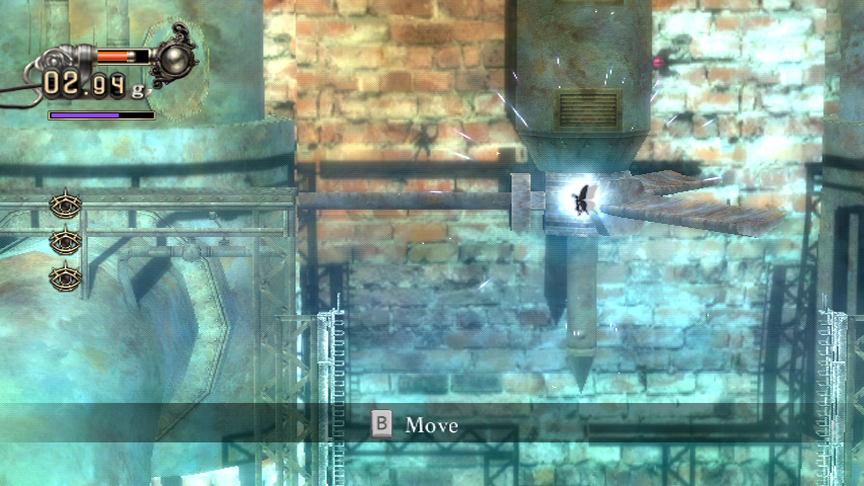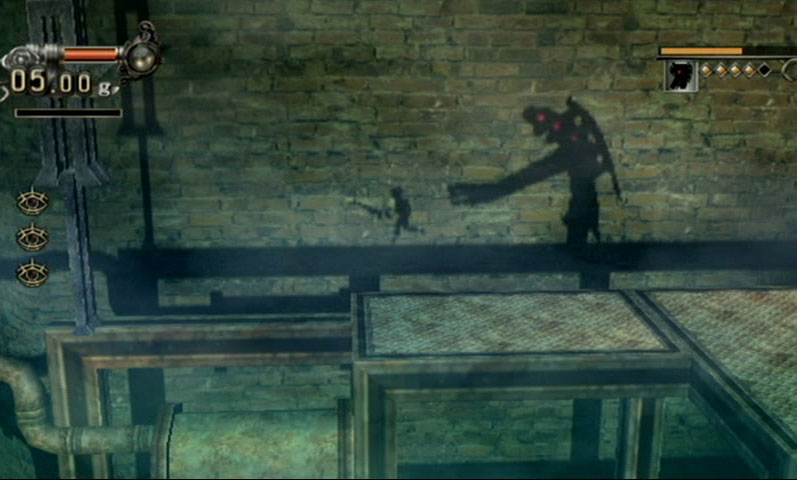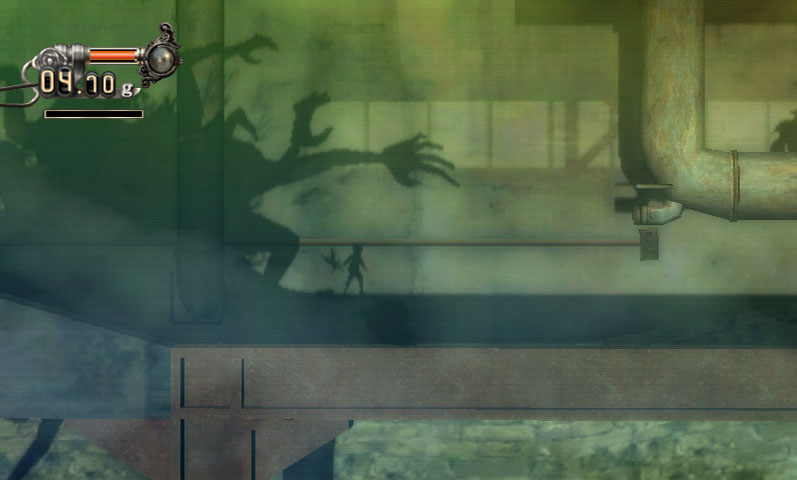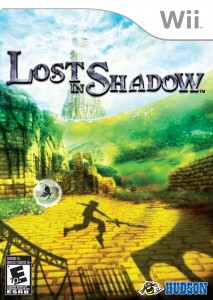System: Nintendo Wii
Genre: Platformer
Players: 1
Developer: Hudson Soft
Publisher: Hudson Soft
Pacing is something that can either make or break a game. Take too long to get to the interesting parts like, say, Final Fantasy XIII and most people won’t stick around to see what comes after all the corridors and tutorials. On the other hand, if the game starts out strong and then loses momentum, gamers will quickly get bored of the whole experience. A great game should be enjoyable from start to finish, and unfortunately A Shadow’s Tale (or “Lost in Shadow” for all you Americans) fails in that regard. The final result is a game with a few interesting ideas that ends up difficult to recommend thanks to some awful pacing and poor design choices.
The premise of the game is promising enough. As the shadow of a young boy (who I’ll just refer to as “your shadow,” since that’s all the game calls him), you find yourself torn from your body and thrown to the foot of a massive tower. Naturally the tower is filled with all kinds of traps and shadow monsters, so getting your shadow’s body back isn’t an easy task. As you progress through the many floors of the tower there are a few cutscenes that give a bit of insight into why your shadow lost his body and why the whole place is crawling with monsters, but the story never really explains much or reaches a satisfying conclusion.
A Shadow’s Tale seems to be heavily inspired by the original Prince of Persia, for better or worse. Though it has the same fluid animation as the 1989 game, the actual platforming hasn’t evolved much. Being a shadow, there are a few neat tricks that give a new perspective on the platforming, like objects in the foreground affecting how the actual level looks and plays, but everything else feels a bit uninspired. At a few points in the game, your shadow gains some neat abilities like the power to move around in three dimensions for a short time with a body made of light, but these are few and far between and the majority of the game feels like padding in between these great moments. While shorter Wiiware games like And Yet it Moves and LostWinds played like fairly standard 2D platformers with a simple gimmick and pulled it off successfully, the novelty of playing as a shadow in A Shadow’s Tale wears off when stretched out across fifteen hours. There are some good ideas here, but they all tend to repeat themselves or take forever to be introduced.
What completely killed the experience for me happened about ten hours in. After finally ascending to the top of the tower, I immediately had to backtrack through previous levels to find a handful of magical macguffins. The occasional elevator sped up the process a bit, but this is still a perfect example of how poor pacing ruins A Shadow’s Tale. There’s definitely reason to go back to previous floors to find previously unreachable areas and items, but that should be left purely to the kind of completionists who scoured Donkey Kong 64 for every single banana.
The game’s most interesting mechanic is Spangle, an odd fairy who accompanies your shadow on his journey and essentially serves as a pointer for the Wii remote. Holding down the B button over specific objects in the foreground allows her (?) to manipulate them, potentially changing the way shadows are cast and creating new paths through the level. This really opens the game up and leads to some of A Shadow’s Tale’s most innovative puzzles, involving things like moving lights to distort shadows or shifting the light source completely and causing the entire level to rotate.

Glowing points show objects in the foreground that you can use Spangle on – in this case, that giant fan.
The controls make good use of the Wii remote, but actually controlling your shadow feels sloppy, especially in the aforementioned 3D sections. Being a shadow himself, the main character doesn’t actually have a shadow so judging depth and distance while he’s made of light can get tricky. Thankfully, the platforming in these sections is kept to a minimum, with the main focus being on boring tasks like rotating platforms and pushing crates. The biggest fault with the game’s control scheme is that it oversimplifies things. Swinging your sword, pulling switches, using Spangle and entering doors are all mapped to the B button, and so there were plenty of instances where
Combat is also a massive pain. Though your shadow is armed with a fairly lengthy sword, it can’t reach very far at all, so the best approach is to run right up to enemies and pray that they don’t try to hit you back. The fact that most of the enemies in the tower can hit harder, faster and further than your shadow makes most encounters frustrating. It’d be fine if your shadow could just avoid enemies or set off traps to damage them, but you often find yourself locked in a room with several monsters and the only option is to fight your way out with your weak 3-hit combo.

Though you can upgrade your sword’s power, enemies like this guy can still hit you before you even get close.
I know games on the Wii are rarely known for having outstanding graphics, but A Shadow’s Tale looks especially rough. For a game based around shadows, they all seem to have a strange flickering effect and often appear incredibly pixelated, something that isn’t helped by the camera’s tendency to zoom in ridiculously close to your shadow. Graphical gripes aside, the game looks very good stylistically. The monster designs are both creepy and creative and the stark environments reminded me of games like Ico and The Legend of Zelda: Twilight Princess. A little variation in the levels would be nice, though. The tower is an interesting place, but it’s mostly filled with boring factories, sewers and gardens. There are also few “Shadow Corridors” scattered around the tower that serve as both checkpoints and bonus stages. They also look completely different to the rest of the game, as they invert all the colours and give everything a weird glow. Design-wise, it’s a breath of fresh air, and I enjoyed these self-contained challenges a lot more than the drab floors of the tower.
There isn’t a whole lot of music in the game, with most of the tower’s floors featuring nothing but ambient noise. There’s nothing particularly interesting about it, but it fits well with the sense of isolation that the developers were aiming for. That’s not to say that A Shadow’s Tale doesn’t have any music at all; there are some instances where the soundtrack was used really effectively. At a few points in the game, your shadow is pursued by a multi-armed monstrosity known as the Shadow Soul. The mix of strings and organs in these sections really cranked up the tension, at least until I realised that touching the Shadow Soul only slowly drains your health, making this fearsome foe not much of a threat at all (until near the end of the game).

The Shadow Soul is creepy the first time you cross paths, but it shows up way too much to be particularly scary.
I can’t fault Hudson Soft for releasing such an ambitious game on the Wii, but for a large portion of the game, A Shadow’s Tale simply isn’t enjoyable. While the developers have created an excellent atmosphere, the actual gameplay leaves a lot to be desired. The platforming is too simple, the combat is too sloppy and —despite some clever ideas with manipulating shadows— the puzzles often boil down to trial and error. The whole concept feels like it’d be better suited to a five-hour long Wiiware game instead of an overlong retail release that starts to drag a few hours in. A Shadow’s Tale is a shadow of what it could’ve been, but those craving an innovative platformer for the Wii could still persevere through this mediocre game for some rare moments of absolute brilliance.
Score: 5/10
